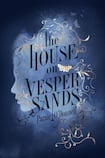
A young man comes to Victorian London in search of his guardian, a troubled woman disappears, a poor little seamstress strives to put a stop to a dreadful conspiracy and grey waves break on the sullen Kent shore where a house broods over Vesper Sands. That faint hum currently disturbing the seismographs of London comes from Westminster Abbey, where Charles Dickens is whirling enviously in his grave.
It takes a certain audacity to write a novel that tips its hat so mischievously to the most celebrated Victorian novelist, but Paraic O'Donnell has more than enough talent to get away with it. The House on Vesper Sands is his second novel after the critically acclaimed Maker of Swans, but there is no trace of difficult-second-novel nerves in this accomplished historical mystery.
The House on Vesper Sands is tightly constructed. It begins with a chilling scene as the seamstress Eleanor Tull throws herself to her death from a grand house in Mayfair, her skin stitched with words clotted in blood. Next, innocent divinity student Gideon Bliss arrives from Cambridge in search of his uncle but discovers a young woman lying on icy flagstones in a parish church, dressed in white. She babbles to him about brightness, black air and danger. The woman is his uncle's ward, a flower-maker, whose tinkling refrain, "Angie Tatton in ribbons of satin", runs through the book.
When Angie disappears, Gideon attaches himself to the police officer who is investigating Eleanor Tull’s death, suspecting that the two women’s fates are intertwined. Inspector Cutter of Scotland Yard is tough, brisk, uncompromising and “has no great gift for looking the other way”. As the two men investigate, rumours reach them about shadowy men nicknamed “the Spiriters” who seek young women, often of low social standing, for purposes too terrible to talk about. Angie Tatton is their most recent target, and she is in terrible danger.
Logic
There is a breath of the supernatural in the plotting of this book, but it’s to O’Donnell’s credit that he doesn’t rely on ghostly happenings to explain or resolve his plot. Instead, there is absolute logic to what people do and why. Even so, the supernatural elements are taken seriously. Often, spiritualism is played for laughs but a seance here is genuinely chilling. There is a sense, at times, of pure evil at work.
The plot zips along, tension rising as the investigation draws towards Vesper Sands and a series of revelations that touch on issues of class, mistreatment of women, power and privilege. But O’Donnell doesn’t break off to moralise. The pace never drops. Nor does he get bogged down in world-building, the fatal flaw for so many historical novelists. The setting is impeccably evoked but in glimpses, as the reader is taken by the elbow and hurried through muddy streets, barely pausing to wonder what a costermonger actually does or why gin shops ever fell out of fashion. It all feels solidly convincing even if the writing is delicate. There is the sense that you are in safe hands, that O’Donnell has done the research so that you needn’t worry about it, that you can safely lose yourself in the world and mystery that he has so skillfully created.
Cutter and Bliss are a wildly mismatched pair and much of the considerable humour here comes from Bliss’s wide-eyed wonder at the Inspector’s short way with obstacles. Stern and sarcastic, Inspector Cutter can be enrolled immediately in the hall of fame of fictional detectives, not least because he is far more complex than he appears at first.
Despite the historical setting this is a thoroughly modern novel, with fully developed characters grappling with their own psychological issues. Again, O’Donnell touches on this rather than dwelling on it at the expense of the plot, but the notes are very definitely struck.
The other main character, Octavia Hillingdon, is a young society journalist who flouts convention whenever possible. Weighed down with the responsibility of developing an aspect of the story that is not immediately compelling, she initially appears to be a sort of Victorian Nancy Drew. However, she comes into her own in the second half of the novel.
The House on Vesper Sands is brilliantly written, compelling and satisfying in so many ways. It demands to be read by a fire on a cold winter evening (but make sure the doors are locked before you begin). I only wish it had been twice as long.















